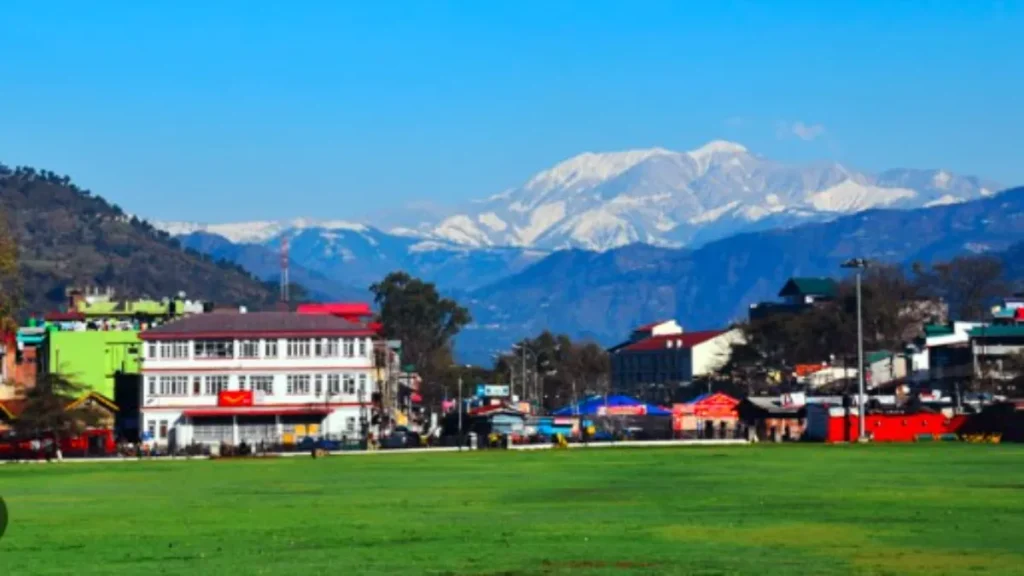Chamba District: HIMACHAL PRADESH
Discover the enchanting beauty and rich cultural heritage of Chamba District in Himachal Pradesh, India. Explore ancient temples, lush landscapes, and vibrant festivals in this serene Himalayan destination.

Chamba District: A Glimpse into the Tranquil Beauty of Himachal Pradesh
Nestled amidst the majestic Himalayan ranges, Chamba District in Himachal Pradesh, India, offers a serene and picturesque escape for travelers seeking natural beauty and cultural heritage. With its captivating landscapes, ancient temples, and rich history, Chamba has carved a unique niche in the hearts of those who venture into its tranquil embrace.
The district’s landscape is a mesmerizing blend of lush green valleys, rolling hills, and pristine rivers. The Ravi River meanders through the region, adding to its scenic charm. Chamba’s natural beauty is perhaps most evident in spots like Khajjiar, often dubbed the “Mini Switzerland of India.” This lush meadow, surrounded by cedar forests and overlooked by the snowy peaks of the Dhauladhar range, is a sight to behold.
Chamba’s rich cultural heritage is another aspect that sets it apart. The region boasts a history that dates back to ancient times, and this legacy is reflected in its architecture, festivals, and way of life. The town of Chamba itself is known for its well-preserved temples, with the Lakshmi Narayan Temple being a prime example. This temple, built in the 10th century, showcases remarkable craftsmanship with intricate carvings depicting mythological scenes.
Festivals are an integral part of Chamba’s cultural fabric. The “Minjar Mela,” celebrated in late July or early August, is one of the most significant events. This week-long extravaganza involves vibrant processions, traditional dance performances, and a fair where locals and tourists alike immerse themselves in the festivities.
Chamba is also a paradise for adventure enthusiasts. Treks to destinations like Manimahesh Lake or the Sach Pass offer a chance to explore the region’s raw beauty up close. The challenging terrain rewards trekkers with breathtaking views and a sense of accomplishment. For those seeking a more laid-back experience, leisurely walks through apple orchards or picnics by the riverbanks are equally satisfying.
The district’s handicrafts, particularly its Pahari miniature paintings, are renowned for their exquisite artistry. These intricate paintings often depict scenes from Hindu mythology and are a testament to the region’s artistic prowess. Visitors can explore local markets to acquire these beautiful pieces of art as souvenirs.
Chamba District’s beauty isn’t confined to its summer allure; it transforms into a winter wonderland when snow blankets its landscapes. The serene white vistas offer a different kind of charm and attract winter sports enthusiasts to explore its potential for activities like skiing and snowboarding.
In conclusion, Chamba District is a haven for those who seek an escape from the chaos of urban life. Its natural beauty, rich history, cultural vibrancy, and opportunities for both relaxation and adventure make it a well-rounded destination. Whether you’re exploring ancient temples, soaking in the local culture, or immersing yourself in the lap of nature, Chamba promises an experience that lingers in memory long after the journey home.
Famous Places in Chamba District
Chamba District in Himachal Pradesh, India, is adorned with numerous famous places that showcase its natural beauty, cultural heritage, and historical significance. Some of the notable destinations include:
Khajjiar: Often referred to as “Mini Switzerland of India,” Khajjiar is a breathtaking meadow surrounded by cedar forests and snowy peaks. Its serene beauty and tranquility make it a must-visit spot for nature enthusiasts.
Lakshmi Narayan Temple: Situated in the heart of Chamba town, this ancient temple is a masterpiece of intricate architecture. Dating back to the 10th century, it features detailed carvings that depict scenes from Hindu mythology.
Manimahesh Lake: A popular pilgrimage site, this high-altitude lake is nestled amidst the towering mountains. The annual Manimahesh Yatra draws devotees who trek to the lake to pay homage to Lord Shiva.
Chamera Lake: Created by the Chamera Dam, this artificial lake offers boating and water sports amid picturesque surroundings. It’s a perfect spot for relaxation and enjoying water activities.
Bhuri Singh Museum: Named after Raja Bhuri Singh, this museum in Chamba town houses an impressive collection of artifacts, miniature paintings, and ancient manuscripts, providing insights into the region’s history and culture.
Kalatop Wildlife Sanctuary: For wildlife enthusiasts, this sanctuary is a haven of biodiversity. It’s home to various species of flora and fauna, making it an excellent spot for birdwatching and nature walks.
Champavati Temple: Dedicated to Rani Champavati, this temple features a distinctive Shikhara-style architecture. Its tranquil ambience and historical significance make it a revered spot for both locals and visitors.
Chaugan: This large open field in Chamba town is a hub of activity during festivals and fairs. It’s a great place to witness local culture, traditional games, and community gatherings.
Akhand Chandi Palace: A blend of British and local architectural styles, this palace once served as the residence of Chamba’s rulers. It offers a glimpse into the regal history of the region.
Sach Pass: An adventurous drive through the Sach Pass takes you to Pangi Valley, offering breathtaking views of the surrounding mountains and valleys. It’s a challenging route that tests the skills of seasoned drivers.
These famous places in Chamba District highlight the district’s diverse offerings, from natural wonders to historical landmarks. Whether you’re a history enthusiast, a nature lover, or an adventure seeker, Chamba has something to captivate every traveler’s heart.
Read More :-
